| Class 1: Explosives
|
| Information on this graphic changes depending on which, "Division" of explosive is shipped. Explosive Dangerous Goods have compatibility group letters assigned to facilitate segregation during transport. The letters used range from A to S excluding the letters I, M, O, P, Q and R. The example above shows an explosive with a compatibility group "A" (shown as 1.1A). The actual letter shown would depend on the specific properties of the substance being transported.
For example, the Canadian Transportation of Dangerous Goods Regulations provides a description of compatibility groups.
- 1.1 Explosives with a mass explosion hazard
- 1.2 Explosives with a severe projection hazard.
- 1.3 Explosives with a fire, blast or projection hazard but not a mass explosion hazard.
- 1.4 Minor fire or projection hazard (includes ammunition and most consumer fireworks).
- 1.5 An insensitive substance with a mass explosion hazard (explosion similar to 1.1)
- 1.6 Extremely insensitive articles.
The United States Department of Transportation (DOT) regulates hazmat transportation within the territory of the US.
- 1.1 — Explosives with a mass explosion hazard. (nitroglycerin/dynamite, ANFO)
- 1.2 — Explosives with a blast/projection hazard.
- 1.3 — Explosives with a minor blast hazard. (rocket propellant, display fireworks)
- 1.4 — Explosives with a major fire hazard. (consumer fireworks, ammunition)
- 1.5 — Blasting agents.
- 1.6 — Extremely insensitive explosives.
|
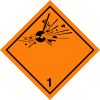
|
Hazardous Materials
|
| Class 1: Explosives
|
|
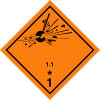
|
Hazardous Materials
|
| Class 1.1: Explosives
|
Mass Explosion Hazard
|
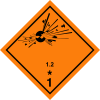
|
Hazardous Materials
|
| Class 1.2: Explosives
|
Blast/Projection Hazard
|
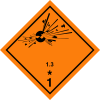
|
Hazardous Materials
|
| Class 1.3: Explosives
|
Minor Blast Hazard
|
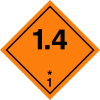
|
Hazardous Materials
|
| Class 1.4: Explosives
|
Major Fire Hazard
|

|
Hazardous Materials
|
| Class 1.5: Blasting Agents
|
Blasting Agents
|
|
|

|
Hazardous Materials
|
| Class 1.6: Explosives
|
Extremely Insensitive Explosives
|
|
| Class 2: Gases
|
Gases which are compressed, liquefied or dissolved under pressure as detailed below. Some gases have subsidiary risk classes; poisonous or corrosive.
- 2.1 Flammable Gas: Gases which ignite on contact with an ignition source, such as acetylene, hydrogen, and propane.
- 2.2 Non-Flammable Gases: Gases which are neither flammable nor poisonous. Includes the cryogenic gases/liquids (temperatures of below -100 °C) used for cryopreservation and rocket fuels, such as nitrogen, neon, and carbon dioxide.
- 2.3 Poisonous Gases: Gases liable to cause death or serious injury to human health if inhaled; examples are fluorine, chlorine, and hydrogen cyanide.
|

|
Hazardous Materials
|
| Class 2.1: Flammable Gas
|
|

|
Hazardous Materials
|
| Class 2.2: Nonflammable Gas
|
|
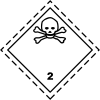
|
Hazardous Materials
|
| Class 2.3: Poisonous Gas
|
|

|
Hazardous Materials
|
| Class 2.2: Oxygen (Alternative Placard)
|
|
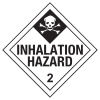
|
Hazardous Materials
|
| Class 2.3: Inhalation Hazard (Alternative Placard)
|
|
|
| Class 3: Flammable Liquids
|
Flammable liquids included in Class 3 are included in one of the following packing groups:
- Packing Group I, if they have an initial boiling point of 35°C or less at an absolute pressure of 101.3 kPa and any flash point, such as diethyl ether or carbon disulfide;
- Packing Group II, if they have an initial boiling point greater than 35°C at an absolute pressure of 101.3 kPa and a flash point less than 23°C, such as gasoline (petrol) and acetone; or
- Packing Group III, if the criteria for inclusion in Packing Group I or II are not met, such as kerosene and diesel.
Note: For further details, check the Dangerous Goods Transportation Regulations of the country of interest.
|

|
Hazardous Materials
|
| Class 3: Flammable Liquids
|
|
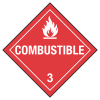
|
Hazardous Materials
|
| Class 3: Combustible (Alternate Placard)
|
|

|
Hazardous Materials
|
| Class 3: Fuel Oil (Alternate Placard)
|
|
|
|

|
Hazardous Materials
|
| Class 3: Gasoline (Alternate Placard)
|
|
|
| Class 4: Flammable Solids
|
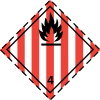
|
Hazardous Materials
|
| Class 4.1: Flammable Solids
|
4.1 Flammable Solids: Solid substances that are easily ignited and readily combustible (nitrocellulose, magnesium, safety or strike-anywhere matches).
|

|
Hazardous Materials
|
| Class 4.2: Spontaneously Combustible Solids
|
4.2 Spontaneously Combustible: Solid substances that ignite spontaneously (aluminium alkyls, white phosphorus).
|

|
Hazardous Materials
|
| Class 4.3: Dangerous when Wet
|
4.3 Dangerous when Wet: Solid substances that emit a flammable gas when wet or react violently with water (sodium, calcium, potassium, calcium carbide).
|
| Class 5: Oxidizing Agents and Organic Peroxides
|
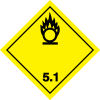
|
Hazardous Materials
|
| Class 5.1: Oxidizing Agent
|
5.1 Oxidizing agents other than organic peroxides (calcium hypochlorite, ammonium nitrate, hydrogen peroxide, potassium permanganate).
|

|
Hazardous Materials
|
| Class 5.2: Organic Peroxide Oxidizing Agent
|
5.2 Organic peroxides, either in liquid or solid form (benzoyl peroxides, cumene hydroperoxide).
|
|
| Class 6: Toxic and Infectious Substances
|
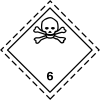
|
Hazardous Materials
|
| Class 6.1: Poison
|
- 6.1a Toxic substances which are liable to cause death or serious injury to human health if inhaled, swallowed or by skin absorption (potassium cyanide, mercuric chloride).
- 6.1b (Now PGIII) Toxic substances which are harmful to human health (N.B this symbol is no longer authorized by the United Nations) (pesticides, methylene chloride).
|

|
Hazardous Materials
|
| Class 6.2: Biohazard
|
- 6.2 Biohazardous substances; the World Health Organization (WHO) divides this class into two categories: Category A: Infectious; and Category B: Samples (virus cultures, pathology specimens, used intravenous needles).
|
|
| Class 7: Radioactive Substances
|
Class 8: Corrosive Substances
|
Class 9: Miscellaneous
|
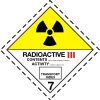
|
Hazardous Materials
|
| Class 7: Radioactive
|
Radioactive substances comprise substances or a combination of substances which emit ionizing radiation (uranium, plutonium).
|
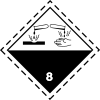
|
Hazardous Materials
|
| Class 8: Corrosive
|
Corrosive substances are substances that can dissolve organic tissue or severely corrode certain metals:
|

|
Hazardous Materials
|
| Class 9: Miscellaneous
|
Hazardous substances that do not fall into the other categories (asbestos, air-bag inflators, self inflating life rafts, dry ice).
|


























